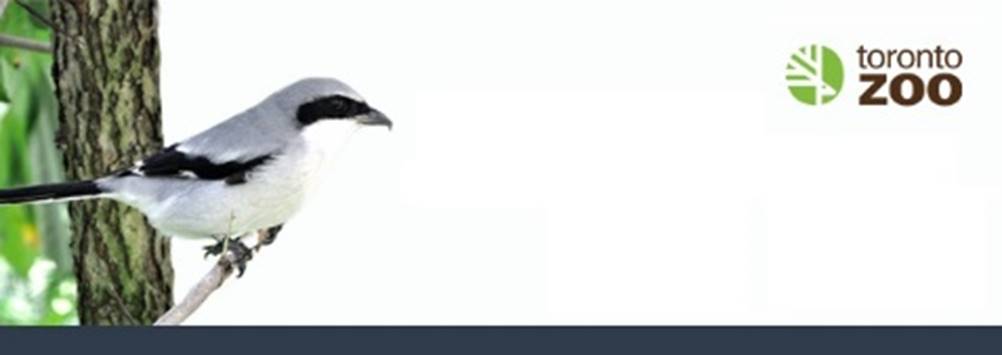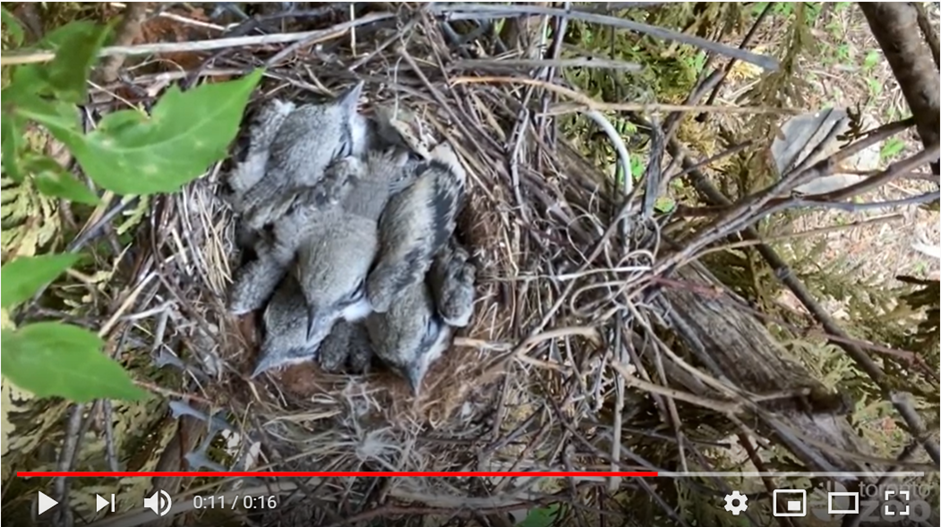
YOUR TORONTO ZOO CELEBRATES CONSERVATION BREEDING SUCCESS OF THE BUTCHERBIRD - EASTERN LOGGERHEAD SHRIKE

TO WATCH EASTERN LOGGERHEAD SHRIKE FLEDGLINGS,
TORONTO, ON, Wednesday, June 16, 2021: Your Toronto Zoo is excited to announce that our Eastern Loggerhead Shrike Canadian Conservation Breeding Program has welcomed hatchings. Your Toronto Zoo has a long and proud history connecting people, animals and conservation science to fight extinction and this flagship Canadian endangered species exemplifies the importance of cultivating a world where wildlife and wild spaces thrive. Known as the Butcherbird, for their behaviour of impaling food on sharp objects such as thorns and barbed wire, these Robin sized birds are at risk and need our help for a brighter future.
The eastern subspecies of the shrike is one of the most imperiled birds in North America. In Canada, shrikes are now only found in a few isolated pockets of grasslands in Ontario, Quebec, and Manitoba. They used to be found readily from southwestern Manitoba, east to the Maritime Provinces. At your Toronto Zoo shrikes are bred and cared for under strict animal care protocols until they can be relocated into suitable habitats in the wild.
In 1991, in response to a rapidly declining population, the Committee on the Status of Wildlife in Canada (COSEWIC) listed the eastern loggerhead shrike as endangered, and it is now protected by provincial endangered species legislation in Ontario, Manitoba, and Quebec. In 1992, a Loggerhead Shrike Recovery Team was formed and recovery plans were produced by 1994. In 1997, when only 100 eastern loggerhead shrikes were estimated to remain in all of Canada and a mere 18 pairs could be found in Ontario, Environment Canada established a captive population to ensure that the unique genetic material of these birds would be preserved. Between 1997 and 1998, 43 young birds were brought into human care and the first conservation breeding followed shortly thereafter. The Toronto Zoo has been involved in the conservation breeding of shrikes since the program’s inception and have released 208 into the wild.
Your Toronto Zoo is proud to announce an extended five-year partnership with Wildlife Preservation Canada (WPC). This partnership is founded upon the shared goal of actively developing and implementing recovery programs to protect Canadian species at-risk outside their natural habitat. WPC and the Toronto Zoo are continuing their long-term collaboration on the Eastern Loggerhead Shrike Conservation Breeding Program, among other species recovery programs. This agreement further establishes objectives that include recovery planning and implementation, research and educational outreach.
“Your Toronto Zoo plays a critical role as one of only a few conservation breeding centres for Eastern loggerhead shrikes and many other endangered species in Canada,” says Dolf DeJong, Chief Executive Officer, Toronto Zoo. “It is our goal to expand this incredible conservation work in order to protect, conserve and increase the populations of shrikes worldwide for future generations,” he added.
This year, your Toronto Zoo has 16 adult shrikes, which formed five breeding pairs that have all produced young. Cohen (dad) and Buffy (mom) had seven chicks hatch on May 10, 2021, followed closely by Kermit (dad) and Bugsy (mom) with four chicks hatched on May 11, 2021. Jack (dad) and Lani (mom), hatched four chicks on May 17th followed by Mike (dad) and Sinead (mom), who had four chicks hatch on May 21st. Last, but certainly not least, Claudius (dad) and Kayleigh (mom) hatched four chicks on May 26th.
Shrikes incubate their eggs for 16-18 days. After hatching, the nestlings remain in the nest for 17 days before fledging the nest and exploring their surroundings, and at around 37 days old, fledglings are ready to leave their parents. Currently among all pairs, 30 eggs have been laid, with 24 young that are now at the fledgling stage of life. Parents are now starting to prepare for their second clutch of eggs so we are expecting more shrikes to come! Most of these young birds will join the wild population this summer.
These breeding and reintroduction programs are putting more endangered species back into the wild. But as important as they are, these conservation programs are funded almost entirely by donations and grants. Your support for our Toronto Zoo’s endangered animal conservation programs – for our shrikes, and all the endangered animals at the Zoo – means you are a partner in the fight against extinction. Find out how you can support these programs through the Toronto Zoo Wildlife Conservancy.
-30-
To learn more about Toronto Zoo’s projects to support Canadian species:
Media Contact Information:
Katie Gray
Manager of Strategic Communications
[email protected]
Amanda Chambers
Toronto Zoo’s Supervisor of Strategic Communications
[email protected]






For general information visit torontozoo.com
The Toronto Zoo’s mission is to connect people, animals and conservation science to fight extinction and our vision is a world where wildlife and wild spaces thrive.
An iconic tourist attraction and Conservation organization, the Toronto Zoo boasts a number of leading programs for helping wildlife and their natural habitats – from species reintroduction to reproductive research. A world-class educational centre for people of all ages, the Toronto Zoo is open every day including December 25 and attracts approximately 1.2 million guests each year.
Toronto Zoo is accredited by Canada's Accredited Zoos and Aquariums (CAZA) and the Association of Zoos and Aquariums (AZA). The Zoo has also achieved the Canadian Council on Animal Care (CCAC) Certificate of Good Animal Practice® and is inspected by the Ontario Ministry of Agriculture, Food and Rural Affairs (OMAFRA).
Toronto Zoo, 361A Old Finch Ave, Toronto ON, M1B 5K7
To unsubscribe, please send your request to [email protected].
View Toronto Zoo’s Privacy Statement
